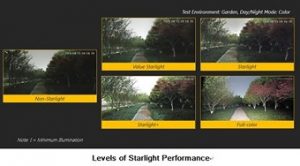
As public security concerns spread across the globe, public areas that lack guard during non-business hours are requiring reliable surveillance equipment in the case of a high crime rate at night or poor lighting conditions. In response, Dahua Technology has addressed this by developing its “Starlight Technology” with a comprehensive camera portfolio including PTZ, IPC and HDCVI to serve various needs of low-light environments.
Compared to traditional video monitoring cameras, Dahua Starlight cameras feature high light sensitivity to provide a brighter view under low-light environments. Offering clear images with rich details and ultra-high definition from 1080P to 4K, the Starlight cameras promise to guarantee 24/7 reliable and detailed monitoring of public places such as parking areas, streets, campuses, stores, etc. In addition, the high colour reproduction and longer colour video period enables the probability of collecting valid human, vehicle, and event evidence.
Under the same lighting conditions, a Starlight camera turns images to black/white later and presents brighter images with far more details whereas a full-colour camera presents 24/7 colour images. From Value Starlight to Full-colour, Dahua Starlight family meets both entry-level and high-end needs according to different lighting conditions. While the Value Starlight camera represents cost-efficient solutions for entry-level markets, Starlight, Starlight + and Full-colour respectively offer individual solutions for common users, critical scenarios and the toughest environments with their various performance levels.
Behind Starlight’s effective performance is Dahua Technology’s strong R&D ability and technological attention, paid to different aspects of the camera. First of all, the Starlight camera employs a high-performance sensor or large-sized sensor with 1/1.8” or even 4/3”inch dimensions to present better light sensitivity. Secondly, a large aperture lens instead of a conventional lens is utilised to present more vivid and brighter images under low-light environments. Then, the high performance DSP and advanced image processing properly balances noise reduction and smear suppression while retaining appreciable clarity, which better enhances the Starlight performance. And, last but not least, proper light compensation, like IR lighting (for B/W images) or LED lighting (for full-colour images) is equipped together with Smart IR or Smart Light technology to present a better night view while avoiding overexposure in totally dark environments.











